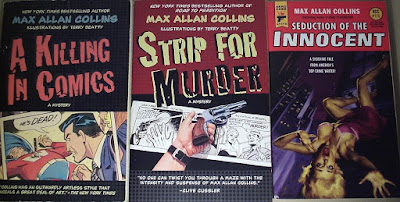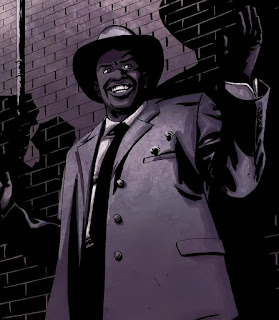Batman: the Animated Series and Batman: Mask of the Phantasm.
Review by Kerey McKenna.
For our next entry in Noir November I wanted to take a look at the movie and TV series that more than any other imprinted noir and pulp sensibilities into my young mind: Batman: Mask of the Phantasm and Batman: the Animated Series. Not only are they among the best iterations of the Batman mythos; they're also a loving tribute to classic film noir.
In 1992, Warner Brothers Animation launched
Batman:The Animated Series to much fanfare by old and young fans alike, a pulpy action cartoon with classic film noir aesthetics and sensibilities. Only a year later the production team managed to take their version of Batman to the big screen with the feature length
Batman: Mask of the Phantasm, resulting in what I propose is one of the best Batman motion pictures ever made.
The narrative of the film actually takes place in two time periods, the “Present” of the TV series (a version of the 1990’s that looks uncannily like the 1950’s; more on that later) in which Batman is well-established as the protector of Gotham, and ten years prior, when a college-aged Bruce Wayne is about to begin his costumed crusade against crime. Going back and forth between the two eras is actually a great way to do the “Superhero origin story” and I’m a bit disappointed no millennial superhero movie has lifted the trick. A fully formed Batman bursts into action in the very first scene, and over the course of the film we get to peer back in time to see the moments that informed the man he would become. Unlike some origin stories of popular characters, these flashbacks don’t obsess about trying to explain every little piece of Batman’s iconography and signature weapons. Instead the grand insight offered by the flashbacks is Bruce Wayne’s state of mind in becoming Batman; along the way they also provide crucial clues to a mystery playing out in the present.

The film begins with present-day Batman doing a bit of gang busting to break up a counterfeiting ring. However things go sideways when a mysterious cloaked figure uses the chaos of the fight to single out the gang’s ring leader and dispatch him with lethal force.

While trying to uncover the identity and agenda of this mysterious Phantasm, Bruce Wayne is haunted by thoughts of more sanguine times, thanks to the return of old flame Andrea Beaumont to Gotham. We learn that ten years ago, just as young Bruce was taking his first forays into vigilante justice, he crossed paths with Andrea, and his caped crusade almost ended before it began. Andrea could have undone Bruce's plans for vengeance by offering him the alternative of a loving and happy life. Unlike the other women of high society—flighty, vain, and gold digging—Andrea knew tragedy through the death of her mother and could relate to the serious and brooding orphan Bruce Wayne on that level, while still offering him a chance at normalcy.
However it seemed destiny had other plans. Andrea mysteriously called off their engagement, leaving Bruce no choice but to throw himself wholeheartedly into his one-man war on crime.
Meanwhile in the present, the Phantasm appears to be targeting specific mobsters for a very personal, but as yet unknown grievance. A grandstanding politician pins the murders on Batman and sics every cop in Gotham who isn’t Commissioner Gordon on Batman’s trail. Further complicating matters, Batman’s archnemesis, the Joker, is on the Phantasm’s hit list and the Clown Prince of Crime decides the best defense is a good offense...and lots of explosives.
The past and present begin to converge as we learn how the Joker, the politician, the targeted mobsters, and the loss of Bruce’s lady love ten years ago are all connected.
With great pacing and a character-defining voice cast (Kevin Conroy and Mark Hamill, voicing Batman and Joker respectively, would reprise these roles many times over the next twenty odd years), Batman: Mask of the Phantasm is a great entry in the superhero canon. But why am I bringing it up as noir?
Dark Deco Design
In 1989, Tim Burton’s summer blockbuster
Batman introduced mainstream audiences to a Gotham far more grim and dark than they remembered from Adam West's 1960’s campy romp. Yet the new gothic take on the material didn’t deter kids (and adults) from shelling out millions of dollars for enough bat-themed bric-a-brac to fill two Bat Caves.
To coincide with the release of the sequel Batman Returns, Warner Brothers turned to their animation studio to keep the momentum going and further capitalize on the character with a Saturday morning cartoon show.
Instead of a toy-centric cash grab, however, the show’s creators set about creating a high quality program that would stand on its own merits as something beyond a movie tie-in. They kept the darker aesthetics of the Tim Burton movies and then leaned hard into anachronisms in the set and prop and character designs to create a style that would be referenced in Warner Animation well into the next century, Dark Deco or Deco Noir. The sets, props, and even the characters themselves have a geometric and streamlined look that is characteristic of the art deco movement, which had experienced a revival during the 1980’s. I believe this was also done as a statement of respect and homage to the Max Fleischer Superman Cartoons of the 1940’s which until then had been the high water mark for realizing a superhero in animation.
Viewers of Phantasm could be forgiven for believing the movie is set some time earlier in the 20th century. Gotham City appears to be stuck in the golden age of art deco design—1930's Streamline Moderne, to be precise, which would dominate city skylines for decades to come. In the TV show, unless it was a very specific piece of technology like a VCR or a supercomputer necessary for the plot, the denizens of Gotham appear to have universally decided nothing designed past 1960 was aesthetically pleasing. Eagle-eyed fans did spot on-screen calendars and documents indicating the show was taking place in the 90’s. However when I poured through the film for this review, I couldn’t spot any obvious anachronisms that would be alien to the 1950’s, save for Batman's crime fighting technology and Joker’s uncannily accurate mini auto-gyro drones.
Adding to the sense that the viewer is looking at something from another time, the creators translated era-appropriate editing and visual effects, such as certain screen wipes, vignetting, and discretion shot pan-aways. Speaking of discretion shots, since this Batman was ostensibly for a family audience, the creators had to work within constraints similar to those classic noir creators laboring under the Hayes production code. While mainstream “neo-noir” creators of the 90’s reveled in the freedom of R-ratings, Batman’s writers used the tricks of the trade of the 30’s and 40’s to sneak a bit of sex and violence into their noir tale but always left the most explicit material to the audience's imagination.

These 1930-50’s film aesthetics were then realized with an often dark palette. Famously, many visuals for the series and the movie were actually created by painting the art on black paper instead of the animation industry standard white. The creators were very careful with their use of light and shadow and the result was a film and TV series that didn’t look like anything else produced by American studios at the time.
Friends from out of town
Any film student worth their salt could tell you that a drastically tilted shooting angle in film can help convey unease, tension, or even madness. It was a popular technique in the film noir canon and also the often psychedelic Adam West Batman. The technique is referred to as a Dutch Angle or Dutch Tilt as it was introduced to American filmmakers primarily from German (Deutsch) impressionist films, and even actual Germans (and other Europeans) who came to the West after the two world wars and wove their own sensibilities into film production.
|
The Batman animated projects that launched in the 90’s also have another international influence on their style—the influence of the Far East. To meet their TV release schedule and a theatrical production time about one-third of what it took a contemporary studio like Disney to get something to the big screen, Warner Brothers
|
Akira (1988)
|
animation had to subcontract a lot of work overseas. For the film, they collaborated with Ong Yang Animations of South Korea and Spectrum Animation of Japan. And while American animated films and cartoons of the time typically weren’t dealing with more “cinematic” shot composition and mature subject matters, a lot of Eastern animation was.
In addition to providing resources for the tedious process of hand drawn animation, these two Asian studios brought much needed experience in how to produce the effects Warner Brothers was looking for. This resulted in…
Standing the Test of Time
A lot of work went into creating an animated Batman that would be taken seriously, and I argue that Batman: The Animated Series and its companion movie Mask of the Phantasm represent a definitive take on the character and mythos. At a time when a Marvel Cinematic Universe would have been considered a fever dream, an animated DC universe of interconnected TV series and further films had already sprung forth from this iteration of Batman. Kevin Conroy and Mark Hamill have been called upon again and again to reprise their roles because to fans of my generation they are the voices of Batman and Joker. In this version of Batman, Efrem Zimbalist, Jr. played Alfred not simply as a loyal, unquestioning servant, but as a man struggling to make sure that Bruce’s quixotic quest doesn’t end in more tragedy. This is the tone struck by every subsequent version of the character in TV and film. As for breakout character Harley Quinn, known to more recent audiences from her central role in 2016's Suicide Squad, she was invented for this series.
In honor of what this version of Batman has meant to fans, this Veterans Day weekend Warner Brothers is airing Batman: Mask of the Phantasm in select theatres throughout the country. If you, like me, are a longtime fan, or if you somehow missed it but are intrigued by anything I’ve described for you, I would highly recommend trying to get yourself a seat for a screening this holiday weekend.
Kerey McKenna is a contributing reviewer to Nerds who Read and SMOF for the annual Watch City Steampunk Festival. Check it out at www.watchcityfestival.com.
, Wings in the Dark
, and The Big Brush-off
. I do like the characters and the overall atmospherics. Combined with the right storyline, the Jake and Laura series would really have something.















